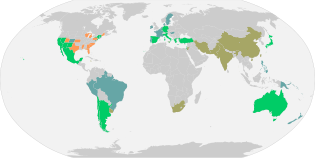Our website is made possible by displaying online advertisements to our visitors.
Please consider supporting us by disabling your ad blocker.
Grid parity
This article needs to be updated. (March 2017) |

Reached grid-parity before 2014
Reached grid-parity after 2014
Reached grid-parity only for peak prices
U.S. states poised to reach grid-parity
Source: Deutsche Bank, as of February 2015 (see file description)
Grid parity (or socket parity) occurs when an alternative energy source can generate power at a levelized cost of electricity (LCOE) that is less than or equal to the price of power from the electricity grid. The term is most commonly used when discussing renewable energy sources, notably solar power and wind power. Grid parity depends upon whether you are calculating from the point of view of a utility or of a retail consumer.[1]
Reaching grid parity is considered to be the point at which an energy source becomes a contender for widespread development without subsidies or government support. It is widely believed that a wholesale shift in generation to these forms of energy will take place when they reach grid parity.
Germany was one of the first countries to reach parity for solar PV in 2011 and 2012 for utility-scale solar and rooftop solar PV, respectively.[2]: 11 By January 2014, grid parity for solar PV systems had already been reached in at least nineteen countries.[3]
Wind power reached grid parity in some places in Europe in the mid 2000s, and has continued to reduce in price.
- ^ "What Is Grid Parity?". Renewable Energy Advisors. Archived from the original on 15 July 2017. Retrieved 27 June 2015.
- ^ "Recent facts about photovoltaics in Germany" (PDF). Fraunhofer ISE. 7 January 2015. Retrieved 17 February 2015.
- ^ "2014 Outlook: Let the Second Gold Rush Begin" (PDF). Deutsche Bank Markets Research. 6 January 2014. Archived (PDF) from the original on 29 November 2014. Retrieved 27 January 2017.
Previous Page Next Page


